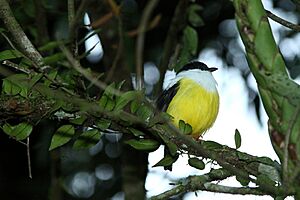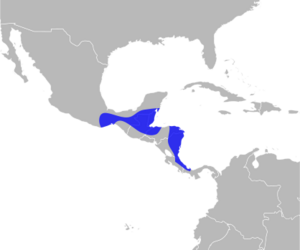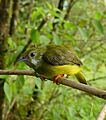White-collared manakin facts for kids
Quick facts for kids White-collared manakin |
|
|---|---|
 |
|
| Male in Costa Rica | |
| Conservation status | |
| Scientific classification | |
| Genus: |
Manacus
|
| Species: |
candei
|
 |
|
The white-collared manakin (Manacus candei) is a small, colorful bird from the manakin family. It lives in warm, tropical areas from southern Mexico down to Costa Rica and western Panama. You can usually find it in thick bushes at the edge of wet forests, in tall, regrowing areas, and even in old cacao plantations. This bird is small and plump, only about 11 centimetres (4.3 in) long.
Male manakins have a black head, a black band across their back, black wings, and a black tail. Their lower back is olive-green, and their belly is bright yellow. Females and young birds are mostly olive-green with yellow bellies. They look a lot like female orange-collared manakins. When it's time to breed, male manakins perform special dances on the forest floor. They puff out their neck feathers to impress females. This bird is quite common and lives in a wide area. Because of this, the International Union for Conservation of Nature says it is a species of "least concern", meaning it's not currently in danger.
Contents
Where Does the White-collared Manakin Live?
This bird is named after Admiral Antoine Marie Ferdinand de Maussion de Candé, who explored South America. It lives in the lowlands and foothills of the Caribbean side of Central America, up to about 700 meters high. On the Pacific side of Costa Rica and Panama, you'll find its close relatives instead. These are the orange-collared manakin (M. aurantiacus) and the golden-collared manakin (M. vitellinus).
The white-collared manakin sometimes mixes with the golden-collared manakin in a small area of Bocas del Toro Province, Panama. When they breed together, their offspring are called hybrids. These hybrids have a lemon-yellow collar on the males. People once thought these birds were a separate species called the almirante manakin (Manacus×cerritus).
This bird prefers to live in thick bushes at the edges of moist forests. It also likes tall areas where trees have grown back after being cut down. You can even spot them in old cacao plantations.
What Does the White-collared Manakin Look Like?
The white-collared manakin is a small bird, just like its relatives. It has a compact body and a short tail. Its bill is strong and hooked, and its legs are orange. The male birds have very bright colors. This bird is typically 11 centimetres (4.3 in) long and weighs about 18.5 grams.
An adult male has a black head, black wings, and a black tail. There is also a black band across the middle of its back. The rest of its head, neck, chest, and upper back are white. Its lower back is olive-green, and its belly is a bright yellow.
The male's wings are special. The five outer feathers are very narrow in their outer half. The inner feathers are thicker and curved. Only the male orange-collared and golden-collared manakins have this unique wing shape. The male's call sounds like a rolled preew. They also use their wings to make a loud snap, like a twig breaking. They can make other rustling and whistling sounds with their special wings.
Female manakins and young males are olive-green with a yellow belly. They look very much like female orange-collared manakins. However, their living areas do not overlap, so you won't find them in the same places.
White-collared Manakin Reproduction and Behavior
Like other manakins, this species has an amazing breeding display. Males gather in a special area called a lek. Each male clears a patch of forest floor, making it bare earth up to 120 cm wide. Then, he leaps back and forth between thin, bare sticks. As he moves, he makes a loud wing snap.
When a female comes to watch, the males jump together. They cross over each other above the bare display court. The males also puff up their throat feathers to form a "beard." The female builds a shallow, cup-shaped nest. She places it 1 to 3 meters high in a horizontal tree fork. She lays two white eggs with brown speckles.
The female does all the work of building the nest and caring for the young. She incubates the eggs for 18 to 21 days. Manakins do not form lasting pairs, so the male does not help with the nest or babies.
The white-collared manakin eats mostly fruit and some insects. It finds its food low in the trees, picking it from the leaves while flying.
Is the White-collared Manakin Endangered?
This bird lives in a very large area and is quite common. Scientists believe there are many white-collared manakins in total. The number of these birds seems to be stable, meaning it's not going up or down much. Because of its wide range and stable numbers, the International Union for Conservation of Nature has listed the white-collared manakin as a species of "least concern". This means it is not currently at risk of becoming endangered.
Images for kids



